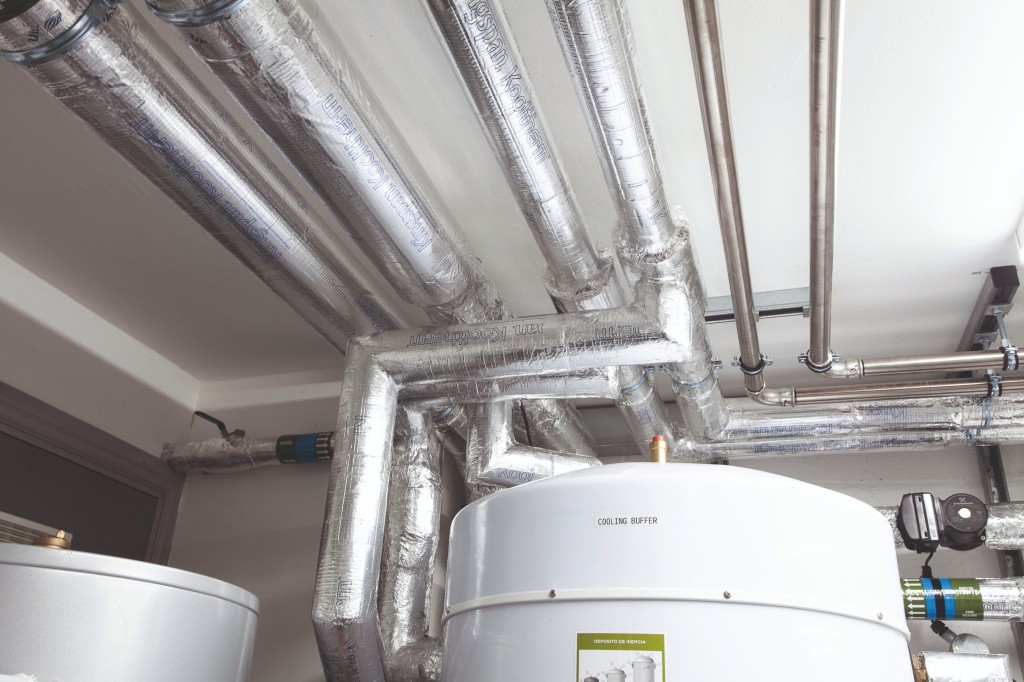The New Standard for Building Services Insulation

Installing the correct thickness of insulation around services is essential to ensure expected performance and project energy targets are achieved. Marc Nickels of Kingspan looks at getting it right.
Installing the correct thickness of insulation around building services is essential to ensure they perform as expected, and that the overall project meets its energy targets. In most cases, specifiers will use the minimum or indicative insulation thicknesses provided within BS 5422 to achieve this.
This standard has recently been updated, introducing new tables covering applications such as secondary pipework for heat networks and setting revised insulation thicknesses, including enhanced thicknesses for certain applications. It’s important for installers to check that the insulation you install meets these new requirements. Additionally, by fitting more thermally efficient insulation, it should be possible to meet the revised targets with a slim thickness of insulation.
BS 5422 explained
BS 5422 covers insulation applications on pipes, tanks, vessels, ductwork and other equipment operating at temperatures between -40oC to +700oC. It offers a range of best practice guidance around insulating building services including addressing condensation and fire risk. The core of the document, however, is a range of tables which provide minimum insulation thicknesses for a range of different systems and scenarios.
The tables within BS 5422 offer minimum or indicative thickness for a wide range of different systems based on factors such as operating temperatures, ambient air humidity and the dimensions, location and orientation of services. The thickness of insulation that is required will change based on its lambda values (also known as its thermal conductivity). The lower the lambda value of an insulation material, the more effective it is at preventing heat loss. This means it may be possible to fit a slimmer thickness of insulation without compromising on thermal performance.
In practice, the thermal performance of building services insulation products can vary a lot. For example, phenolic pipe insulation products can achieve aged thermal conductivities as low as 0.025 W/mK. By contrast, mineral fibre lagging typically only achieve thermal conductivities of 0.033 W/mK or worse. This can have a significant impact on the thickness of insulation which is needed and knock-on effects on how close together services can be fitted, and how easy they are to lag in compact areas.
All pipe insulation products should be supplied with clear information about their thermal conductivity. This value will be affected by the mean temperature of the insulation. To find the correct mean insulation temperature for an application, you add the operating temperature of the system to the ambient temperature and then divide this value by 2; this produces a curved graph.
Key Updates in BS 5422:2023
BS 5422: 2023 introduces several key changes which installers need to be aware of. The pipe insulation tables have been greatly simplified. There are no longer separate tables for steel and copper pipework and all pipe sizes are indicated as “less than or equal to”. In addition, many of the rarely used thermal conductivities have been removed. This should make it easier to identify the correct system and insulation thickness. New tables have been added, one of which covers requirements for secondary systems as part of heat networks.These should be read together with the guidance in CIBSE CP1 – Heat Network Code of Practice.
However, it is important to note that they are also applicable to non- residential schemes, unlike CP1. A number of tables with enhanced insulation thicknesses are also provided. This incorporates the standards from the Energy Technology List, and can support efforts to achieve net zero operational emissions, or to reach a desired level in voluntary standards such as LEED. The standard signposts use of these enhanced standards by stating that unless there are specific instructions from the specifier, insulation levels from the enhanced tables should be used. Use of pipe insulation materials with lower thermal conductivities, such as phenolic insulation, can result in more notable thickness savings when reaching these enhanced values.
In addition, references regarding reaction to fire performance now solely use the Euroclass system and single wall plastic pipework is now considered to have no insulative value of its own.
Further Revisions Expected
It’s important to note that the updated standard has been released based on the 2008 edition of the BS EN ISO 12241 calculation standard. This has now been superseded by a 2022 edition. It’s therefore expected that the tables within BS 5422: 2023 will be recalculated once a calculation tool becomes available. The updated standard has a significant impact on calculating thicknesses for condensation control, and will lead to some widespread thickness changes when incorporated.
As mentioned, building service insulation manufacturers should be able to provide tables with recommended thicknesses for their products to meet BS 5422: 2023. When requesting or receiving these – check they’re using the 2023 version of the document.
Delivering on Expectations
As the fabric of buildings are insulated to higher standards, energy losses from poorly insulated building services can take on increased significance in the overall energy demand of the building. By ensuring the insulation you install meets the updated requirements within BS 5422, installers can be confident that specifications are meeting good practice.







